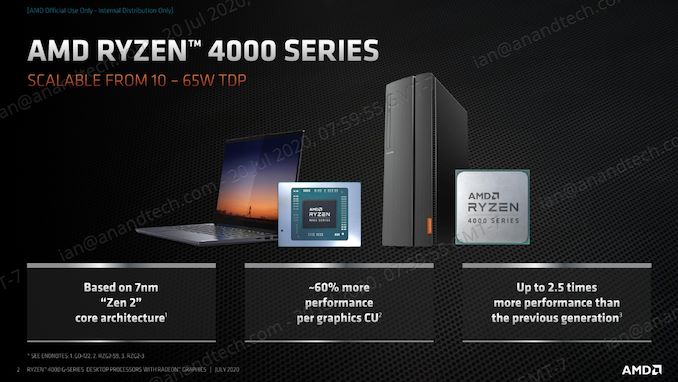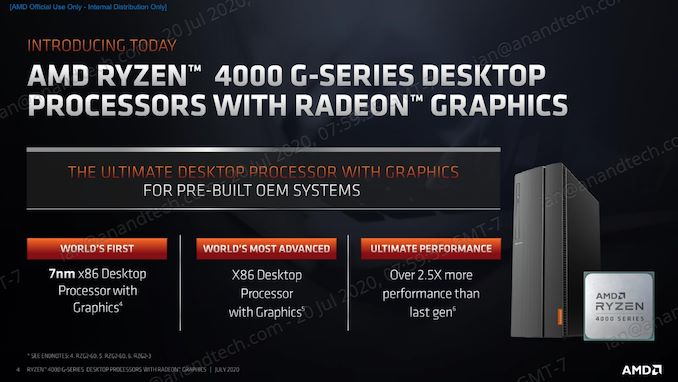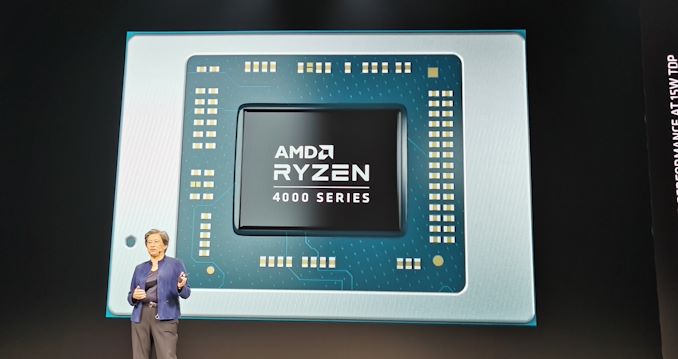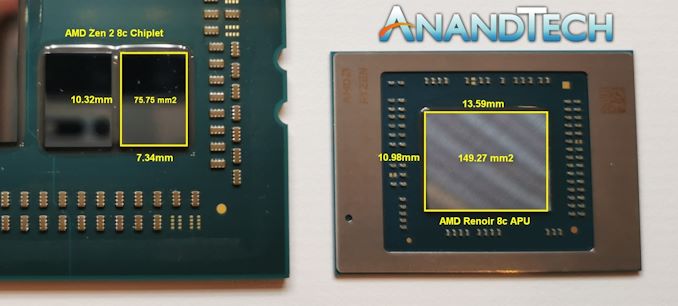AMD Launches 12 Desktop Renoir Ryzen 4000G Series APUs: But You Can’t Buy Them
by Dr. Ian Cutress on July 21, 2020 9:00 AM EST
Today AMD is finally lifting the lid on its long-awaited desktop Zen2 based APU family. Using the same silicon as in the Ryzen Mobile 4000 family, AMD is pumping it up into 35 W and 65 models in the same AM4 platform that is in use today. There has been strong demand from PC builders to release these chips, which were on the topics of forum conversation all the way back at CES. There’s only one downside to these new processors: you can’t buy them on their own. AMD states that the initial release of Ryzen 4000G hardware is for OEMs like Dell and HP only for their pre-built systems.
The new processors use the same 8-core Zen2 plus 8 compute unit Vega that we saw in Ryzen Mobile 4000 at the beginning of the year, but as with previous APU launches, the frequency and power thermals have been pushed up into more manageable desktop environments. To that end, AMD will be launching hardware in the Ryzen 7, Ryzen 5, and Ryzen 3 product lines at both 65 W and 35 W, all on the AM4 platform.
| AMD Ryzen 4000G Series APUs | |||||||
| AnandTech | C/T | Base Freq |
Turbo Freq |
GPU CUs |
GPU Freq |
PCIe * |
TDP |
| Ryzen 4000G | |||||||
| Ryzen 7 4700G | 8 / 16 | 3600 | 4400 | 8 | 2100 | 16+4+4 | 65 W |
| Ryzen 7 4700GE | 8 / 16 | 3100 | 4300 | 8 | 2000 | 16+4+4 | 35 W |
| Ryzen 5 4600G | 6 / 12 | 3700 | 4200 | 7 | 1900 | 16+4+4 | 65 W |
| Ryzen 5 4600GE | 6 / 12 | 3300 | 4200 | 7 | 1900 | 16+4+4 | 35 W |
| Ryzen 3 4300G | 4 / 8 | 3800 | 4000 | 6 | 1700 | 16+4+4 | 65 W |
| Ryzen 3 4300GE | 4 / 8 | 3500 | 4000 | 6 | 1700 | 16+4+4 | 35 W |
| Ryzen Pro 4000G | |||||||
| Ryzen 7 Pro 4700G | 8 / 16 | 3600 | 4400 | 8 | 2100 | 16+4+4 | 65 W |
| Ryzen 7 Pro 4750GE | 8 / 16 | 3100 | 4300 | 8 | 2000 | 16+4+4 | 35 W |
| Ryzen 5 Pro 4650G | 6 / 12 | 3700 | 4200 | 7 | 1900 | 16+4+4 | 65 W |
| Ryzen 5 Pro 4650GE | 6 / 12 | 3300 | 4200 | 7 | 1900 | 16+4+4 | 35 W |
| Ryzen 3 Pro 4350G | 4 / 8 | 3800 | 4000 | 6 | 1700 | 16+4+4 | 65 W |
| Ryzen 3 Pro 4350GE | 4 / 8 | 3500 | 4000 | 6 | 1700 | 16+4+4 | 35 W |
| *PCIe lanes on the SoC are listed in GFX+Chipset+Storage | |||||||
The top processor is the Ryzen 7 4700G, coming in at 65 W TDP with a base frequency of 3.6 GHz and a turbo frequency of 4.4 GHz. It uses all eight compute units for the graphics, running at a mind-numbing 2100 MHz.
At the lower end is the Ryzen 3 4300G, with four cores and eight threads, with a base of 3.8 GHz and a turbo of 4.0 GHz, which should mean that performance is very consistent. This part has six compute units for graphics, running at 1700 MHz.
Every version has a GE counterpart at 35 W, which for the most part reduces the base frequency and TDP only. The exception is the Ryzen 7, where 100 MHz is lost on turbo and 100 MHz is lost on graphics.
All the APUs support DDR4-3200, and have sixteen PCIe 3.0 lanes for add-in cards, as well as four PCIe 3.0 lanes for storage. On the PCIe lanes, the reason this is PCIe 3.0 and not PCIe 4.0 is because the equivalent mobile chip was built with eight PCIe 3.0 lanes for add-in cards, to save on power in a mobile environment. AMD sees these chips being used mostly on their own without a separate discrete graphics card, given that the company already has the Ryzen 3 CPU family for those that want discrete graphics.
At the same time as the Ryzen 4000G APUs, AMD is also launching the Ryzen Pro 4000G versions for the commercial market. These specifications mirror the standard Ryzen counterparts, but fall under AMD’s Pro Technologies feature set, with additional security, manageability, and business ready pillars. This includes full memory encryption and support for DASH management, OS image stability over 18 months, guaranteed processor availability for 24 months, and enhanced QA.
So they are OEM only? What?
Just to be clear, AMD specified OEM and not system integrators (SIs). On our call, AMD clarified that the market for its APUs is skewed very heavily towards the big mass-market prebuilt customers like HP and Dell, rather than custom home builds. The numbers quoted were around 80% of all APU sales end up in these systems, and by working with OEMs only, AMD can also help manage stock levels of the Renoir silicon coming out of the fabs between desktops and notebooks.
What this means is that unless you are choosing to buy a pre-built office-focused business PC, then the only way to get hold of these processors would be through distributors who are selling them piecemeal – AMD is not creating official boxes and bundles with coolers for these processors.
Those pre-built office-focused business PCs are expected to be out shortly. Just in case you control a corporate budget and need a few hundred of them.
Will we ever get Ryzen 4000 APUs for Desktop?
AMD says that they are planning a consumer-grade release of APUs ‘soon’. It was stated in our briefing call that there will be a launch of a future Zen2 APU for the consumer market compatible with 500-series motherboards. The company specifically did not say 400-series, but did clarify that the 4000G series announced today was for 400 and 500 series.
When exactly this launch will come, and what it will be, and what price ranges AMD will be aiming for is unclear. As mentioned, we were discussing Zen 2 based Renoir desktop APUs with vendors back in January, and at this point it certainly feels late to the game. Could AMD be hiding something up its sleeve? A PCIe 4.0 version perhaps (would this require new silicon?) or maybe something up at the 105 W TDP performance level? It really is unclear.
There’s also some new Zen+ APUs
For the lower end of the prebuilt market, AMD is also offering a new set of Zen+ APUs. These are the first desktop parts to carry the Athlon Gold and Athlon Silver branding.
| AMD Athlon 3000G Series | |||||||
| AnandTech | C/T | Base Freq |
Turbo Freq |
GPU CUs |
GPU Freq |
PCIe * |
TDP |
| Athlon 3000G | |||||||
| Athlon Gold 3150G | 4 / 4 | ? | 3900 | 3 | 1100 | 8+4+4 | 65 W |
| Athlon Gold 3150GE | 4 / 4 | ? | 3800 | 3 | 1100 | 8+4+4 | 35 W |
| Athlon Silver 3050GE | 2 / 4 | 3400 | - | 3 | 1100 | 4+2+2 | 35 W |
| Athlon Pro 3000G | |||||||
| Athlon Gold Pro 3150G | 4 / 4 | 3500 | 3900 | 3 | 1100 | 8+4+4 | 65 W |
| Athlon Gold Pro 3150GE | 4 / 4 | 3300 | 3800 | 3 | 1100 | 8+4+4 | 35 W |
| Athlon Silver Pro 3125GE | 2 / 4 | 3400 | - | 3 | 1100 | 4+2+2 | 35 W |
| PCIe lanes on the SoC are listed as GFX+Chipset+Storage | |||||||
We believe these to be based on the same silicon as the Athlon Gold and Athlon Silver mobile parts. We're still waiting on full details for the 3000G family.
The Final Word: We were told that there will be a reviewers’ guide shared with us. Whether that is for these OEM-only parts, or for something upcoming, we don’t know. But we have our fingers crossed.















130 Comments
View All Comments
Farfolomew - Wednesday, July 22, 2020 - link
I'm referring more of the impending doom of x86 as a whole. Look at how Arm and the sandbox-OS world dominated the smartphone market since 2007. That model is so incredibly more user-friendly than the x86 Windows world.I'm honestly shocked the Windows world has lasted this long. The consumer computer space is ripe for a big paradigm shift towards user simplicity, even if power users [most of] us don't like it
wumpus - Thursday, July 23, 2020 - link
Changing platforms is a huge pain. The real issue is "that one app" you can't live without (you can, but you'd buy a whole system to run that app anyway). The real problem for ARM is that "that one app" is different for everybody, and emulation isn't always good enough.I'd have thought that Chromebook would be enough to move people to ARM. If it wasn't, I'd be surprised if an ARMMac would do it, although it might be enough to get developers developing on ARM (which might be enough of a push to overthrow x86).
I think the real question, is why are game consoles still on x86? I suspect that a "real computer" will still have its place (although don't expect everyone else to keep subsidizing us, although AMD might be able to survive on such margins and keep their traditional pricing).
JasonMZW20 - Monday, August 3, 2020 - link
Counterpoint: AMD holds a custom ARM license and can create their own ARM-based processors and SoCs if the gap is significantly closed in HPC (server/datacenter/AI), and can offer both ARM and x86, as was the original plan.I don't see AMD ever offering ARM for consumer/retail products (right now), but you never know.
brucethemoose - Tuesday, July 21, 2020 - link
Going up is one thing. Thats why I bought them at... 8, I think?But this is an established company trading at a P/E of 135. Thats more like "AMD is going to monopolize the market and make 20x what they make currently, in a few years."
This is partially a reflection of my frustration with the entire US stock market, which, as Warren Buffet recently said, is in "la la land".
lightningz71 - Wednesday, July 22, 2020 - link
The stock market is trapped in an artificial environment that exerts constant upwards pressure on its overall valuation. Due to the simply massive amounts of money that are poured into it by funds that are constantly being pumped full of additional 401k/IRA/etc money, and managers that are judged by only their most recent quarter’s performance, anything that shows even the slightest chance of riding gets an avalanche of money thrown at it.It is almost completely irrational in how it behaves.
bananaforscale - Wednesday, July 22, 2020 - link
^ This.jospoortvliet - Sunday, August 2, 2020 - link
Yup. The quantitative easing (“printing money”) causes inflation in the market where that money ends up. 50 years ago, that money would have end up with normal folks who would buy fridges and houses, so their prices would go up and we would have inflation. But our economy is so skewed towards the 1% that almost all the money printed just makes the rich, richer. And they don’t spend it, they invest it - in the stock market. Which this is now seeing inflation.The smarter move would be to massively increase tax on the rich, globally, and transfer that wealth to people who spend it - so it benefits the economy instead of just creating crazy numbers on the stock market. Alternatively instead of giving the money to the rich as the govt now does, hand it over to people who spend it - directly. The 600 dollars/week has had more positive effect on the economy as all other money thrown at the economy in the last decade combined...
vanilla_gorilla - Tuesday, July 21, 2020 - link
I wouldn't call this boring! I've been waiting for new AMD APU to upgrade my tiny mini-itx NAS. It's currently using a >85w 4c/8t part from intel and I would love to upgrade it.Pmaciel - Tuesday, July 21, 2020 - link
You have a perfectly legitimate use for these APUs — yet can't buy them.eek2121 - Tuesday, July 21, 2020 - link
I'd love to get my hand on the 35W part for a Mini ITX multipurpose PC (media, light gaming, etc.)I imagine they are just delaying the launch due to supply issues. TSMC can only produce so many parts.